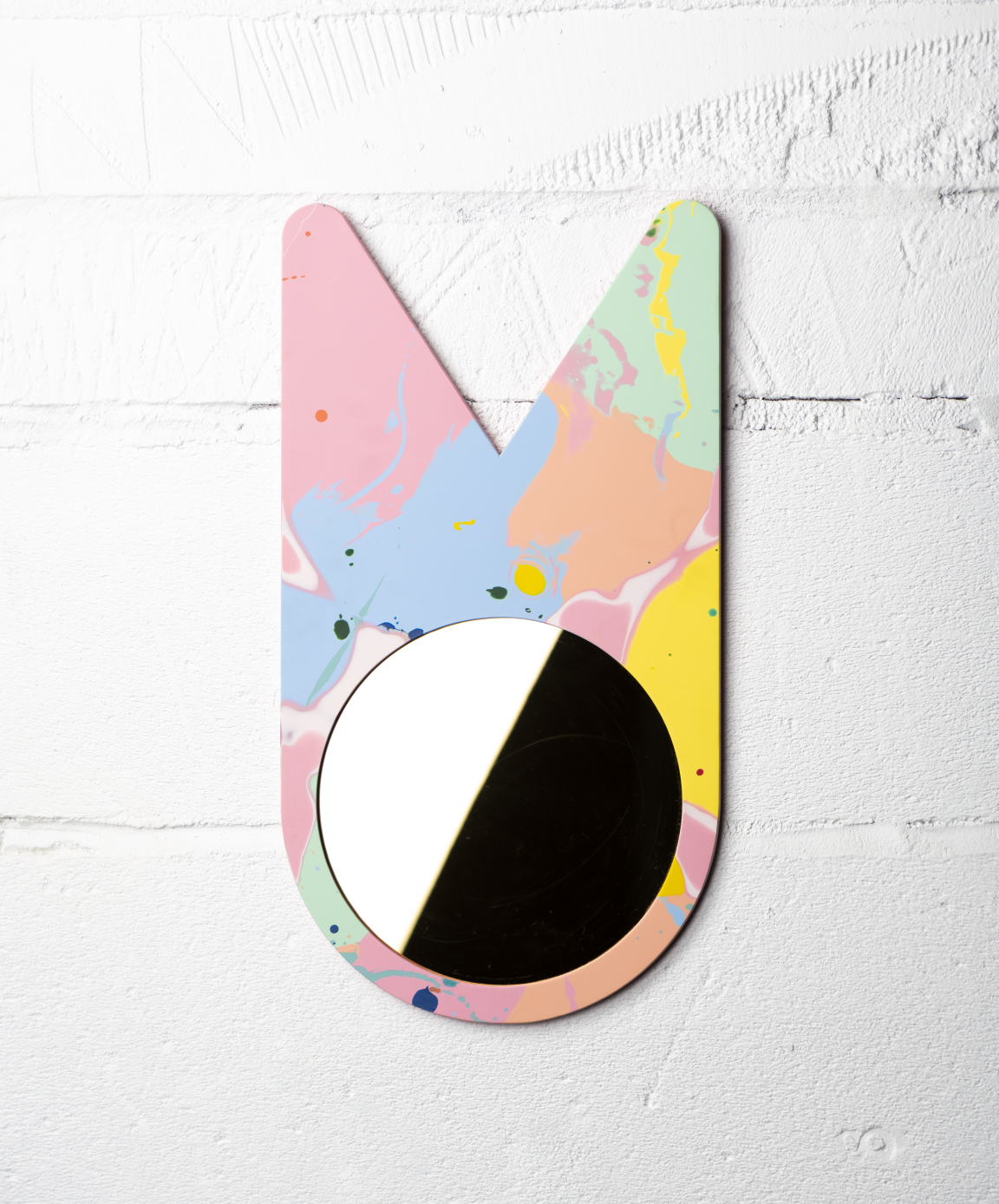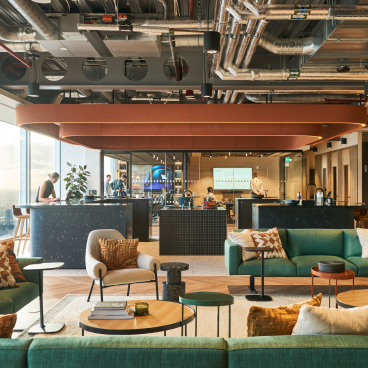Surface design studio, Mirrl, on Japanese lacquerware, collaborative projects, and sourcing inspiration in unlikely spots.

Situated in Govanhill on Glasgow’s Southside, the surface design start-up, Mirrl sets out to create colourful, maximalist sheet materials that embody true originality and Scottish craftsmanship.
Co-founded by Simon Harlow and Lewis Harley, Mirrl is inspired by making methods inherent in traditional Japanese craft - a technique called Tsugaru Nuri. Through layering and sanding back numerous coatings of different coloured resins on a plywood substrate, the process yields a highly resilient, long lasting, waterproof, food safe, repairable, joinery-ready surface material similar to Japanese lacquerware for a wide span of interior and exterior applications.
Simon and Lewis met at the Glasgow School of Art, joining together later in life to form Mirrl. The design duo has now undertaken a multitude of projects across Scotland and beyond, with Mirrl specified in residential, hospitality, and retail settings to name a few.
Keen to learn more about this innovative material start-up, we caught up with Simon and Lewis to hear all about Mirrl.
Firstly, could you please introduce us to Mirrl?
“Hello! We’re Mirrl, a material-based start-up focused on exquisite surface finishes. Originally we fell in love with Japanese lacquerware, a specific type called Tsugaru Nuri, and wanted to bring it to Europe in our own way.
“We spent years figuring out how to get that same look but with a more resilient finish, and we’ve been developing versions of it, and our own creations ever since. We’re now a small team, working from Govanhill in the Southside of Glasgow, producing a weird and wonderful range of finishes.”


Where can this material be applied, and across what sectors?
“It’s best suited for flat surfaces that want to be both aesthetically pleasing and hardwearing for a long time. However, it can create really interesting effects when used on contoured surfaces or within 3D applications.
“It quickly captures people’s curiosity, as you can’t really tell what it’s made from. It can give the visual impression of a solid, extremely heavy, mineral block, or it can look like a delicate, thin surface cover. It depends on what you do with it.
“It works well with a wide variety of applications, spanning; restaurant tables and bar tops, kitchen surfaces, decorative mouldings, sculptures, furniture, yacht interior cladding, car dashboards, flooring, wet rooms, sinks. The list goes on.”
Talk us through how this material is designed and manufactured
“The design process is usually a close collaboration between us and the client. We start with a clear resin, so anything is possible really. We do offer a few standard colours, but mostly people want to work with us to make their own special thing, and we like to do that, it’s more interesting for us that way.
“Manufacture is a slow, craft-based process, and some of it can’t be disclosed. However, in essence we mix colours into resin, layer them up in different ways and numerous times, and then sand them back to reveal the finished pattern.”
Mirrl's surface qualities are almost hypnotic, adding visual interest into any scheme. Where does the inspiration for this material come from?
“Well, the process is driven by the mechanical properties of the resin, so we rely on pure physics to dictate the look. Within this methodology you can look at pretty much any other natural process that generates a ‘look’ from the laying down of materials, one on top of another, and we take inspiration from that.
“For example, there was a bit of seagull shite that had been sat on a rock by the sea for a while. Put plainly, it had rained a few times over the last week and so some fungus or algae had grown around it, feeding on the nutrients. However, it then died in the heat of the sun so had peeled away a bit, curled up and changed colour, leaving a really clean linear boundary between the shite and the organism. Small moments like this in nature stand as inspiration for a colour layer that could well be incorporated!”

What led you as co-founders of Mirrl to set up your studio in the city of Glasgow?
“We were old friends from Glasgow School of Art (GSoA) a very long time ago and had found something we thought would be good to work on together.”
Tell us about your collaborative project with the University of Dundee's botanical garden
“We’d been working with Susanna Beaumont for a few years, and she had suggested for us to design a fountain in order to provide clean water for free all year round for any visitors to the Botanics. It was requested the fountain make some kind of reference to the place itself through the chosen colours. She quickly mentioned that rhubarb was developed as a new species variant in Dundee. And so, rhubarb was our inspiration starting point.
“Through looking at images of rhubarb, we immediately realised it was a no brainer as the colours were amazing, full of vibrant greens, yellows, pinks, reds. A playground for us! We developed some versions and presented them, and refined them until we hit a sweet spot."


You have an exciting library of core colourways for specifiers to choose from. But for those - as you say - with a focused aesthetic in mind, how do you approach your bespoke projects?
“Each of our panels are bespoke, meaning that our colourways start out as clear resin and then get hand tinted by us to make the right colour. So, for existing colourways we use our recipes to get the look but for bespoke colourways we work closely with the client to design, test, and make what they need.
“Sometimes they’re not 100% sure how their vision will look and they want a steer from us, which works well as we’ve a good sense of what will work and what won’t. Other times they just tell us the colours they want to use, and we produce a good look with that particular colourway. We’re more than happy to work either way with people.”


A recent collaboration of yours is with artist, Adam Nathaniel Furman. Could you tell us about this and how it emerged?
“Well this all happened through Instagram turns out. We have a keen interest in ‘ArchiFringe’ (Glasgow) and what they do. As the name suggests it’s quite a political and progressive discursive platform about architecture in general, and with a focus on what happens in the country of Scotland. Part of one of their annual exhibitions was ANF’s ‘democratic monument’, which is quite a nihilistic, celebratory, eclectic and cohesive model of a town hall.
“I was very smitten by it and decided to get in touch with him through Instagram and see if he wanted to see some of what we did. He was very receptive, and we went on to develop some furniture and homewares together.”
And finally, what's next for Mirrl?
“Many things! We’re aiming to transition from being a stressed and clumsy start-up into a more proficient manufacturing SME, without losing any of the passion or ideas within our formation. We’re also developing a new product using an existent waste stream to create more circular products. In addition to all of this, we’re soon launching a new collaboration with the designer, David Ross of Half Year Studio.”

You can view the exhibited work Mirrl has collaborated on with designer, David Ross of Half Year Studio at the Makers in Residence: Scotland showcase at Material Source Studio, Glasgow. And, should you like to learn more about how you can incorporate Mirrl’s surface materials into your next project, click here.




